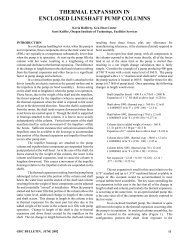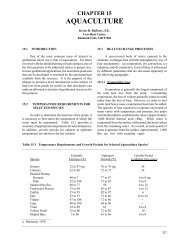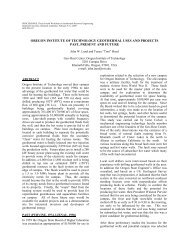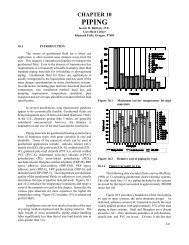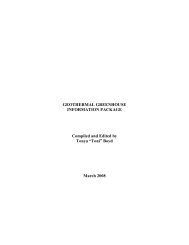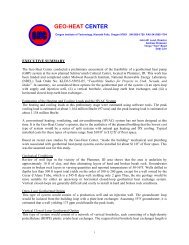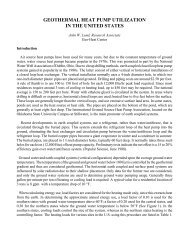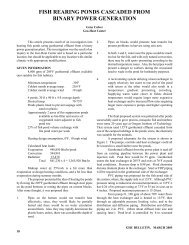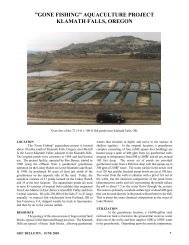Companion Study Guide on Short Course on Geothermal ... - OSTI
Companion Study Guide on Short Course on Geothermal ... - OSTI
Companion Study Guide on Short Course on Geothermal ... - OSTI
Create successful ePaper yourself
Turn your PDF publications into a flip-book with our unique Google optimized e-Paper software.
Table 8. Critical Velocities for Erosi<strong>on</strong>-Corrosi<strong>on</strong> of Four Copper Alloys<br />
CA 122<br />
CA 706<br />
CA 715<br />
CA 722<br />
Alloy Comm<strong>on</strong> Name<br />
Deoxidized Copper<br />
90-10 Cupr<strong>on</strong>ickel<br />
70-30 Cupr<strong>on</strong>ickel<br />
90-10 Cupr<strong>on</strong>ickel +<br />
Chromium<br />
* Values calculated based <strong>on</strong> 0.75 inch diameter tubing and 77 o F water.<br />
Critical velocity calculati<strong>on</strong>s based <strong>on</strong> work by Efird (1977).<br />
6.1<br />
14<br />
15<br />
39<br />
Critical Velocity*<br />
(ft/sec) Reynolds Number *<br />
1.77·10 4<br />
5.60·10 4<br />
6.00·10 4<br />
1.56·10 4<br />
Note: Standard c<strong>on</strong>servative design practice suggests limiting bulk fluid velocity to <strong>on</strong>e-half the critical velocity to<br />
allow for turbulence at tube inlets, etc.<br />
Stainless Steel<br />
Unlike copper and cupr<strong>on</strong>ickels, austenitic stainless steels (including Type 304 and Type 316)<br />
are not affected by traces of hydrogen sulfide in the geofluid. These alloys are subject to pitting and<br />
crevice corrosi<strong>on</strong> above a threshold chloride level which depends up<strong>on</strong> the temperature of the<br />
geofluid. Above this temperature, the passivati<strong>on</strong> film, which gives the stainless steel its corrosi<strong>on</strong><br />
resistance, is ruptured in local areas and/or in crevices. These ruptured areas then corrode in the form<br />
of pitting and crevice corrosi<strong>on</strong>. Figure 1 showed the relati<strong>on</strong>ship between temperature, chloride,<br />
and occurrence of localized corrosi<strong>on</strong>. The fact that localized corrosi<strong>on</strong> can occur does not predict<br />
its severity, but <strong>on</strong>e should expect more severe attack as the chloride-temperature c<strong>on</strong>diti<strong>on</strong>s intrude<br />
further and further into the localized corrosi<strong>on</strong> regi<strong>on</strong>. As discussed previously, prudent design<br />
should avoid selecti<strong>on</strong> of materials which are subject to pitting and crevice corrosi<strong>on</strong>.<br />
5.4 ISOLATED vs. NON-ISOLATED SYSTEM DESIGNS<br />
GHP systems can be either n<strong>on</strong>-isolated or isolated systems. In a n<strong>on</strong>-isolated system, the<br />
geothermal water is circulated directly through the evaporator. In isolated systems, the geofluid<br />
passes through an isolati<strong>on</strong> heat exchanger where heat is transferred to treated water flowing in a<br />
closed loop between the isolati<strong>on</strong> heat exchanger and the evaporator. The isolated system suffers a<br />
thermal penalty because of the temperature drop across the isolati<strong>on</strong> heat exchanger, and it does<br />
require an additi<strong>on</strong>al heat exchanger, piping, pump and c<strong>on</strong>trols.<br />
Isolati<strong>on</strong> systems have the advantage of protecting the heat pump or pumps from the<br />
corrosive and scaling problems produced by the geofluid. Plate heat exchangers (PHXs) are<br />
comm<strong>on</strong>ly used to minimize the cost of the isolati<strong>on</strong> heat exchangers, even when exotic metals like<br />
titanium are used, as well as to simplify cleaning. Indeed, the largest geothermal heat pump system<br />
in the world, a district heating system in the Paris Basin, France, uses titanium PHXs to protect banks<br />
of water-source heat pumps (Trolano, 1980).



